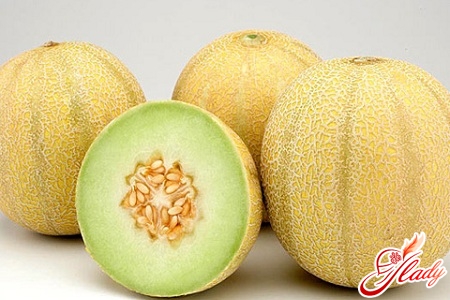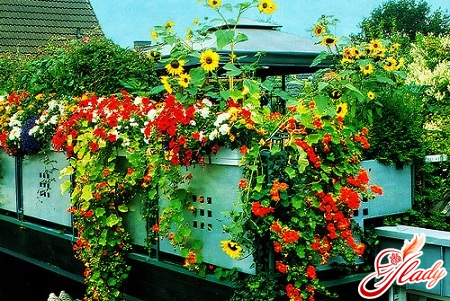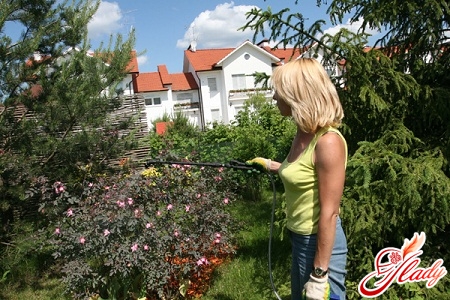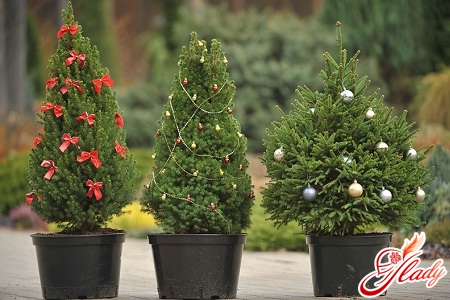 Sweet peppers are very rich in vitamins andmineral substances, contains proteins and sugars, fatty and essential oils, citric, malic and oxalic acids. One pepper fruit contains the daily norm of vitamin P, and the content of vitamin C in it makes it a real champion among vegetables. Therefore, sweet pepper has long been firmly included in the list of the most favorite garden crops that are grown in household plots. Pepper belongs to the nightshade family, which is very susceptible to late blight. But this misfortune bypasses pepper. Caring for it is very simple, and even novice summer residents can grow it. But in order to get a rich harvest of this vegetable crop in the summer, you need to know how to grow pepper seedlings. When growing seedlings in greenhouses or at home, seeds can be planted in pots or cups with a diameter of 8-10 centimeters, seedling cassettes or standard seedling boxes. In warm greenhouses, they are planted directly in the ground. Often, the seeds are first planted in a box, and after the first true leaves appear, they are transplanted into pots.
Sweet peppers are very rich in vitamins andmineral substances, contains proteins and sugars, fatty and essential oils, citric, malic and oxalic acids. One pepper fruit contains the daily norm of vitamin P, and the content of vitamin C in it makes it a real champion among vegetables. Therefore, sweet pepper has long been firmly included in the list of the most favorite garden crops that are grown in household plots. Pepper belongs to the nightshade family, which is very susceptible to late blight. But this misfortune bypasses pepper. Caring for it is very simple, and even novice summer residents can grow it. But in order to get a rich harvest of this vegetable crop in the summer, you need to know how to grow pepper seedlings. When growing seedlings in greenhouses or at home, seeds can be planted in pots or cups with a diameter of 8-10 centimeters, seedling cassettes or standard seedling boxes. In warm greenhouses, they are planted directly in the ground. Often, the seeds are first planted in a box, and after the first true leaves appear, they are transplanted into pots.
Seed preparation
Before you grow pepper seedlings, you need toprepare seeds so that peppers give a large and stable harvest. First of all, it is necessary to select good seeds. Then prepare them for sowing in order to grow good seedlings from them. To begin with, you can sort the seeds by eye, discarding broken, small and empty ones. Then the seeds should be pickled in a slightly warm solution of potassium permanganate of a dark purple color. The seeds should be kept in it for 20-30 minutes, and then thoroughly rinsed with running water. Then the seeds need to be warmed up. This can be done by placing them in a thermos for two hours, where the water temperature is 40-50 ° C. You can also warm the seeds in running warm water. This dramatically increases the germination of seeds - after such preparation, they will sprout faster. Now the seeds are ready for sowing.
Soil preparation
Sweet peppers, unlike hot peppers, are not verytolerates picking well, so it is better to plant expensive varieties of sweet pepper immediately in a separate container. But on the other hand, the "tastes" of pepper seedlings change as they grow, and if at first it is good to take a nutrient mixture of garden and humus soil in equal proportions, then at subsequent stages the seedlings "like" loose soil with less nitrogen, but enriched with other minerals. For example, a mixture of peat and sawdust in a ratio of 7:3. To do this, you need to mix lowland and high-moor peat in different quantities, although you can use pure high-moor slightly decomposed peat, provided that liming materials are added to it to remove excess acidity. For top dressing, 30-40 g of superphosphate, 7-10 g of urea, 3 g of magnesium sulfate and 10-15 g of potassium sulfate should be added to the soil mixture per bucket of soil. If you do not pick peppers, you can leave them in any of the listed mixtures. Then their yield will be less than when picking, but the loss will not be so significant, so you should not experiment with high-yielding varieties.
Growing seedlings
If you are interested in how to grow peppers at home,then you should know that before pouring the soil mixture into the boxes or pots, it is necessary to put good drainage on the bottom so that the water does not stagnate and the roots do not rot. A layer of soil mixture 7-8 cm thick should be poured into the box on top of the drainage layer. The surface of the soil is leveled, and then furrows are made on it, spaced 5-6 cm apart. Pre-prepared seeds are laid out in these furrows at a distance of 1-2 cm from each other. Then the holes in the cup or the furrows in the box are filled with a layer of sand or humus 0.5 cm thick. After this, the soil should be slightly compacted. The planted seeds should be watered well from a watering can, holding it low so as not to wash the seeds out of the soil with a strong stream of water. Then the containers can be covered with plastic wrap or glass. After this, until the shoots appear, the containers are placed in a warm place. It is not necessary for it to be light. To germinate well, pepper seeds need a temperature of 22-28°C, so at home you can place the box near the radiator, making sure that the soil in it does not dry out.
Care of seedlings
Pepper is a light-loving plant, so it lovesgood lighting. When the shoots begin to appear, the container with seedlings should be immediately moved to a lighted place, for example, to a windowsill. If there is no such place, then you need to provide illumination with a lamp. The lamp will also be needed to illuminate the seedlings during prolonged cloudy weather. They need to be illuminated for as long as the daylight hours last in clear weather. You need to carefully monitor that the seedlings do not get under drafts, even for a short time. Because of them, they will weaken, get sick and may even die. This often happens when pepper seedlings are grown on a windowsill at home, so be sure to check the place where you will put the pepper seedlings for the possibility of drafts. Do not leave slightly open windows near the seedlings. If the room needs to be ventilated, then place the seedlings under polyethylene caps or mini-greenhouses made of glass jars.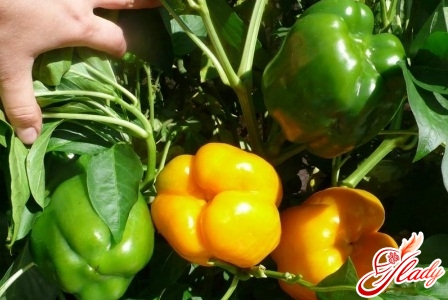
Watering of seedlings
Pepper loves a lot of water, and if there is not enough of it, itthe fruits grow crooked, small and tasteless. The seedlings also need to be watered well: very often and so that the soil is always slightly damp, but not wet. The water for irrigation should be warm, not lower than room temperature, because cold water can not only make the seedlings sick, but also kill them. In addition, you need to make sure that the air is not too dry. Therefore, if you grow seedlings at home, where the heating is on, and the air is dry because of this, then the plant needs to be sprayed every day, and the room should be ventilated, covering the pepper from drafts. After the first true leaves appear on the pepper, the seedlings should be carefully pricked out. Then the seedlings need to be watered well. When growing seedlings in pots, at first they are placed close together, and then gradually moved apart so that the leaves of the seedlings do not cover each other.
Seed dressing
If the seedlings are dark green, they are growing.Okay, then you don't need to feed it. But if the seedlings are weak, they should definitely be fed. Experts generally advise feeding the seedlings twice during the forcing period:
- the first time - when the majority of seedlings will have three or four real leaflets;
- the second time - when the real leaves will be already five or six.
A good fertilizer is liquid fertilizer."Effect", one cap of which is diluted in five liters of water. You can feed the seedlings with bird droppings, which need to be diluted with hot water in a ratio of 1:20. You do not need to insist it, so that there is no smell. You can also use a complete mineral fertilizer, for which you need to dilute one teaspoon in five liters of water. In order for the fruits to be of higher quality, you should arrange foliar feeding with micronutrients. This is done by spraying.
Hardening of seedlings
Two weeks before planting the seedlings in the groundyou should start hardening it, accustoming it to fresh air and lower temperatures. To do this, you can first simply open a vent or window in the room, and in the following days take the seedlings out onto the balcony or veranda on clear days, or even outside. Gradually increase the time the seedlings spend in the fresh air. It should be noted that such hardening is done only when the air has already warmed up to 15 ° C. Start hardening with twenty minutes a day, gradually increasing the time. Experts advise hardening the seedlings, and not the seeds warmed up in warm water. Two or three days before planting pepper seedlings in the ground, you need to do a preventive treatment against late blight, for which dilute a pinch of copper sulfate and boric acid in three liters of hot water. Cool the solution and spray the seedlings in the morning or evening before planting. Seedlings are planted in the ground only after the soil has warmed up well, and its temperature is above 15 ° C. However, this can be done no earlier than two months after the emergence of shoots. Only in the southern regions can seedlings be planted after one and a half months. Peppers are planted in a sunny place, well protected from the wind. The readiness of seedlings for planting can also be determined by their appearance. If the seedling has from seven to eight to ten true leaves, and its height is 20-30 cm, then such seedlings are ready for planting in the ground. The yield of sweet peppers depends especially strongly on the age of the seedlings: it grows the most fruits on those bushes whose seedlings were planted in a permanent place 80-90 days after the emergence of shoots, while the yield of sixty-day seedlings is sometimes almost two times lower.
Planting of seedlings
Before planting, the seedlings should be watered so thatso that the soil softens well. In the garden bed, you need to make furrows or holes in advance. The seedlings are placed in them at the same depth at which the seedlings grew. That is, you do not need to dig in the root collar and expose the roots. If you grew seedlings in pots or cups, then you can put them in the ground directly with them, cutting the cup in the hole in several places. Most often, seedlings are planted in rows or two-row tape method. When peppers are planted in rows, the distance between them should be about half a meter for hot peppers, and even more for sweet vegetables - 70 cm. In a row between plants, the distance should be 10-15 cm for hot and 15-30 cm for sweet peppers, depending on the variety. It should be borne in mind that the larger the bush, the greater the distance between them should be. The tape method implies that narrower row spacings, the distance between which is 40 cm, alternate with wider ones - 80-90 cm. In a row, the distance between plants should be the same as in the first method.
Bezrossadny method
If you are interested in how to grow peppers at home,then you should know that in warm areas and southern regions it can be grown without preliminary growing of seedlings. In this case, the seeds are sown in the soil only when it warms up to a temperature of at least 8°C, usually not earlier than mid-April. The seeds are covered with soil 2-3 cm thick, that is, they need to be planted deeper than the seeds are planted for seedlings. Another question is whether it is worth growing peppers in this way, because with late sowing, the harvest of such peppers will ripen later, and the fruiting period will be shorter. This means that the total harvest will also be smaller. We recommend reading:




